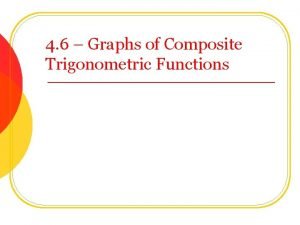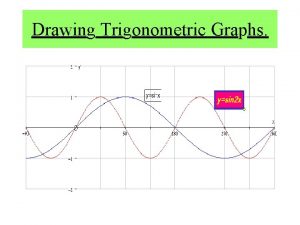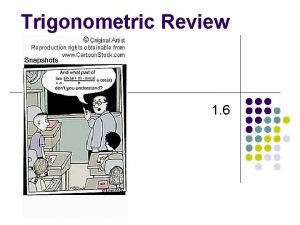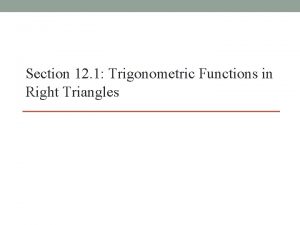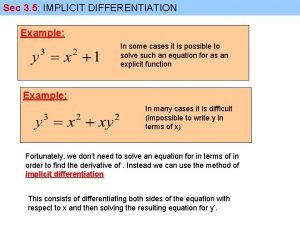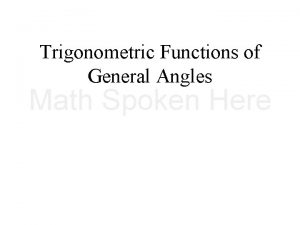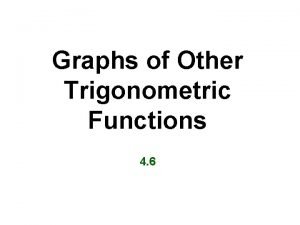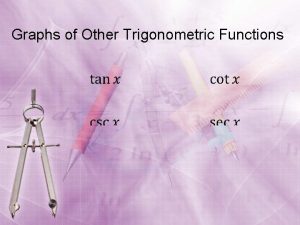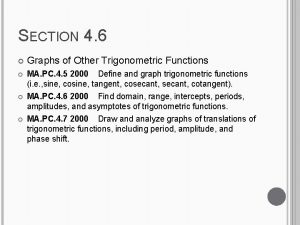1 6 Graphs of Other Trigonometric Functions Part



















- Slides: 19

1. 6 Graphs of Other Trigonometric Functions Part 1

Graph of the Tangent Function Recall that the tangent function is odd, that is tan(-x) = -tan x Therefore, the graph of y = tan x is symmetric with respect to the origin.

Graph of the Tangent Function You also know that tan x = sin x/cos x. Therefore it is undefined when? ? When cos x = 0. This is when x = π/2 and x = - π/2

Lets make a chart and find points for the graph: x -Π -1. 57 -1. 5 -1 0 1 1. 57 2 Π 2 tan x undef. -1255. 8 -14. 1 -1. 56 0 1. 56 14. 1 1255. 8 undef. tan x approaches - ∞ as x approaches –π/2 from the right tan x approaches ∞ as x approaches π/2 from the left

Analyzing the chart: x -Π -1. 57 -1. 5 -1 0 1 1. 5 -1. 57 2 Π 2 tan x undef. -1255. 8 -14. 1 -1. 56 0 1. 56 14. 1 1255. 8 undef. tan x increases forever as it approaches π/2 from the left ∞ ∞ tan x decreases forever as it approaches -π/2 from the right Therefore, the graph has vertical asymptotes at x = π/2 and x = - π/2

Graph of the Tangent Function: Because the period of tangent is π, vertical asymptotes also occur when x = π/2 + nπ

Characteristics of the Tangent Function Vertical asymptotes are where cos x = 0 (odd multiples of π/2) Period π Domain: all x ≠ π/2 + nπ Range (-∞, ∞)

Transformations of y = tan x l Sketching the graph of the form y = a tan(bx – c) is similar to sketching the graph of y = a sin(bx – c). l You will locate key points and identify the intercepts and asymptotes. l Two consecutive asymptotes can be found by solving the equations: bx – c = - π/2 l bx – c = π/2 The midpoint between these two asymptotes is an x-intercept of the graph.

Transformations of y = tan x l After plotting the asymptotes and the x-intercept, plot a few additional points between the two asymptotes. l Sketch one cycle. l Finally, sketch one or two additional cycles to the left and right.

Transformations of y = tan x Remember: l Shifts (vertical & horizontal) are done as the shifts to y = sin x. l Period change (same as to y = sin x, except the original period of tan x is π, not 2π). l Tangent has no defined amplitude, since the graph increases (or decreases) without bound.


Sketch the graph of = tan(x/2) l y First, find the asymptotes: Solve the equations x = -π 2 2 and x = π 2 2 x = -π and x = π Therefore, two consecutive asymptotes occur at x = -π and x = π

Sketch the graph of y = tan(x/2) Between the two asymptotes x = -π and x = π, plot a few points, including the x-intercept. Make a table of x and y values: x -π/2 0 π/2 y = tan(x/2) -1 0 1

x -π/2 y = tan(x/2) -1 0 0 π/2 1 Graph of y = tan(x/2) Asymptotes at x = - π and (π/2, 1) (0, 0) (-π/2, -1) x=π

Graph y = -3 tan (2 x) l Solve the equations: 2 x = -π/2 and 2 x = π/2 x = - π/4 and l l l x = π/4 You can see that two consecutive asymptotes occur at x = - π/4 and x = π/4 Between these asymptotes, plot a few points, including the x-intercept. Make a table of these values: x y = -3 tan(2 x) -π/8 3 0 0 π/8 -3

x -π/8 0 y = -3 tan(2 x) 3 0 π/8 -3 Graph of y = -3 tan(2 x) Asymptotes at x = - π/4 and (-π/8, 3) (0, 0) π 2 -π 2 (π/8, -3) x = π/4

Compare If a > 0, then the graph is increasing between two consecutive asymptotes. l If a < 0, then the graph is decreasing between two consecutive asymptotes. l There is a reflection in the x-axis. y =tan(x/2) y = -3 tan(2 x) l

Classwork: Section 1. 6 Practice Worksheet The Graph of the Tangent Function

Homework:
 Composite trigonometric functions
Composite trigonometric functions 5-3 polynomial functions
5-3 polynomial functions Csc a
Csc a Translations of trigonometric graphs
Translations of trigonometric graphs Trigonometric drawing
Trigonometric drawing Lesson 4 from circle-ometry to trigonometry
Lesson 4 from circle-ometry to trigonometry Encoding bugs in software testing
Encoding bugs in software testing Graphs that compare distance and time are called
Graphs that compare distance and time are called Graphs that enlighten and graphs that deceive
Graphs that enlighten and graphs that deceive Cofunction identity
Cofunction identity Three basic trigonometric functions
Three basic trigonometric functions Partner of sine and cosine
Partner of sine and cosine Period of trigonometric functions
Period of trigonometric functions 12-7 graphing trigonometric functions answers
12-7 graphing trigonometric functions answers 12-1 trigonometric functions in right triangles
12-1 trigonometric functions in right triangles Differentiating both sides
Differentiating both sides 9-5 practice graphing trigonometric functions
9-5 practice graphing trigonometric functions Trigonometric functions domain and range
Trigonometric functions domain and range Trigonometric function
Trigonometric function Find the exact value of . a. c. b. d.
Find the exact value of . a. c. b. d.
